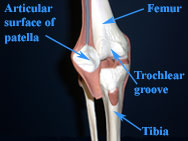|
Conditions & Treatments - Chondromalacia Patella |
|

Chondromalacia patella (CMP) is a
condition at the knee commonly found in younger athletes and in
females where the articular cartilage under the patella
(kneecap) softens or becomes damaged. Since the patella sits in
the groove of the trochlea of the femur (thigh bone) and moves
smoothly up and down in this groove with knee motion it can be
susceptible to injury. The cartilage under the patella can
become injured as a result of direct trauma to the knee, overuse,
and malalignment of the patella as a result of muscle imbalance
or postural/anatomical abnormalities. The mechanism of injury
is thought to be the result of the patella rubbing on the knee
joint behind it which stresses the articular cartilage surface
of the patella and leads to inflammation and pain to the area.
Last revised: August 14, 2010
|
|
|
|
|





